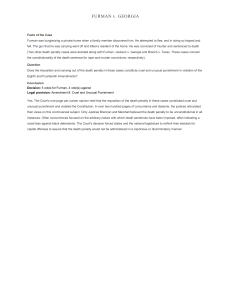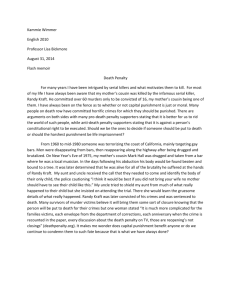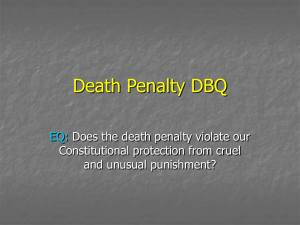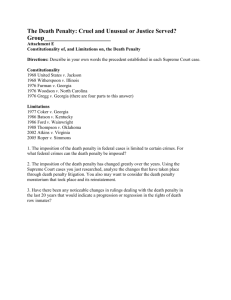Current Issues
advertisement
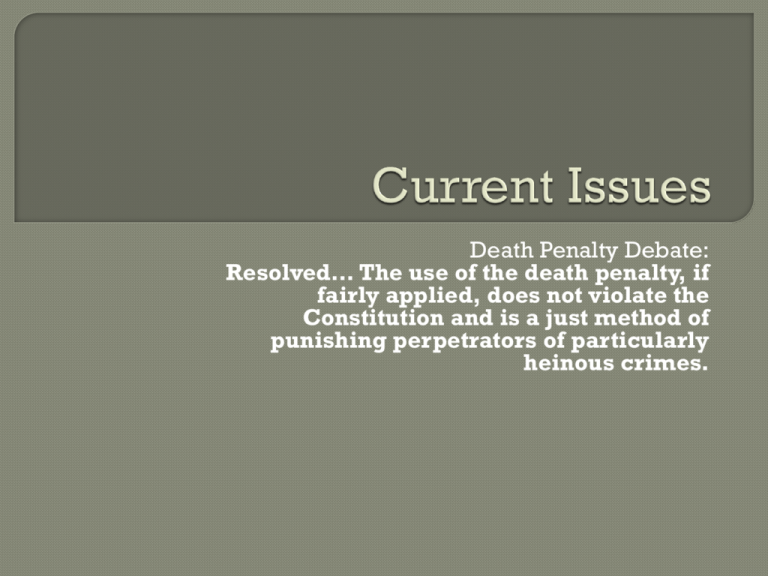
Death Penalty Debate: Resolved… The use of the death penalty, if fairly applied, does not violate the Constitution and is a just method of punishing perpetrators of particularly heinous crimes. Bell Work… 1.What is capital punishment? 2.In what types of crimes is capital punishment used as a penalty? 3.Does Colorado allow for the death penalty? If so, what is the procedure for implementing the death penalty? Capital Punishment Introduction What is cruel and unusual punishment? Does the Constitution outlaw cruel and unusual punishment? “Excessive bail shall not be required, nor excessive fines imposed, nor cruel and unusual punishments inflicted.” Torture, burning at the stake, crucifixion, drawing and quartering etc. In Wilkerson v. Utah (1879), the Supreme Court stated that intent of the framers was to prevent such barbaric punishments and “all others in the same line of unnecessary cruelty.” In In re Kemmler (1890), the Court upheld execution as a legal method of punishment (New York). Since the late 1800’s, the Courts seemed to have skirted the issue regarding the death penalty- essentially the Court did not want to rule on such a highly charged issue. Most European countries have banned execution (86 all together have banned it). China leads the world in executions- 470 in 2007. Finally in 1972, the Court indirectly issued a ruling regarding the death penalty. In Furman v. Georgia (1972), the Court struck down all existing State laws allowing for the death penalty- but not because it was cruel and unusual. Instead, the Court ruled that State laws gave too much discretion to judges or juries in deciding whether or not to impose the death penalty. Simply stated, the Court said that out of all the people convicted of capital crimes, only “a random few” mostly minorities and or the poor “were capriciously selected” for execution. This did not outlaw the death penalty, only the way the penalty was implemented. How did States fix this problem? 38 States passed new capital punishment laws. The new laws took one of two forms… Some States made the death penalty mandatory for certain crimes (killing a police officer, murder rape, kidnapping, arson). Other States provided for a two-stage process in capital cases- 1) a trial to determine guilty; 2) a hearing to decide whether the circumstances justify a sentence of death The first method of mandatory sentencing was found to be unconstitutional- the Court stated that such laws were “unduly harsh and rigidly unworkable”. The two-stage approach has been ruled to be constitutional. In Gregg v. Georgia (1976) the Court ruled that a well-drawn two stage laws could practically eliminate “the risk that the death penalty will be inflicted in an arbitrary or capricious manner.” The Court also latter clarified that the death penalty can only be used in crimes that result in death (Coker v. Georgia). Important to note, that capital punishment has been challenged quite a bit in the court system. Yet over the past 30 years, the death penalty, if fairly applied, has been considered constitutional. 1999 highest level of people executed (98). 2007 42 executed, mostly in Virginia and Texas Yet, many still disagree with the implementation of the death penalty- Gov. George Ryan of Ill. Gov. Ryan, in 2000, placed a moratorium on all executions in the state because he believed the process was “fraught with error”. Out of 285 people sentenced to death from 1977, 12 had been executed but 13 were released from prison after being wrongly convicted. 35 out of 36 states use lethal injection (Nebraska uses electrocution, some states allow for the choice- one uses firing squad as a choice) Generally excepted to be humane if properly used. Three drug volley, but if the first wears off, similar to drowning or a massive heart attack South Carolina study- 13 inmates probably suffered an ill administered death Challenged the constitutionality of the 3 drug system on the above grounds. Supreme Court Ruling, 7 to 2 decision, lethal injection is a reasonable method. Both states eliminated the death penalty due to DNA advances, but mostly for the time and expense of the death penalty application. 2002, 8th amendment ruling barred execution of the mentally ill. 2005, Roper vs. Simmons case ruled that juveniles should not be executed. 2008, death penalty can not be used for instances of child rape- only for murder or treason. Gallop Poll numbers showed that the nation is equally divided regarding the death penalty. DNA advances- proven that some inmates were incorrectly imprisoned. African Americans are more likely to suffer the death penalty than whitesdiscriminatory? Studies (according to the NY Times) have shown the death penalty to be a deterrent (3 to 18 murders prevented) Should the government put people to death? Does the death penalty serve as a deterrent? Does the death penalty implementation discriminate against minorities? What about the possibility of executing innocent people? Given the idea that most democratic countries have banned the death penalty, why does the US still use it?



